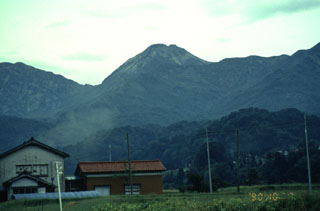Report on Niigata-Yakeyama (Japan) — September 1987
Scientific Event Alert Network Bulletin, vol. 12, no. 9 (September 1987)
Managing Editor: Lindsay McClelland.
Niigata-Yakeyama (Japan) Small ash eruption; fuming
Please cite this report as:
Global Volcanism Program, 1987. Report on Niigata-Yakeyama (Japan) (McClelland, L., ed.). Scientific Event Alert Network Bulletin, 12:9. Smithsonian Institution. https://doi.org/10.5479/si.GVP.SEAN198709-283090
Niigata-Yakeyama
Japan
36.921°N, 138.036°E; summit elev. 2400 m
All times are local (unless otherwise noted)
A small ash ejection is presumed to have occurred between late April and 1 May when brown snow was observed on the flank. At 1000 on 2 May fume clouds were rising 30-50 m from the NE part of the summit. Plume height reached 100 m on 4 May, and on 19 May 100-150-m-high clouds issued from three sites on the NE flank and one site on the SE flank. Similar activity was seen on 27 May, when seven sites were active; two emitted grayish fume and had yellow sublimates.
On 8 June fuming continued from one site at the summit and two sites on the upper NE flank, but at lesser volumes than in May. By 18 June the fume reached only 20-30 m. When observed on 19, 23, and 29 July, clouds rose 70-100 m from 2-3 sites on the upper NE flank and in the summit region. Eight fuming sites were visible on 7 August from the foot of the mountain and small amounts of white fume were rising 50-70 m. Observations on 7 and 11 August showed discoloration in the area from the summit to the upper E flank.
Geological Summary. Niigata-Yakeyama, one of several Japanese volcanoes named Yakeyama ("Burning Mountain"), is an andesitic-to-dacitic lava dome in Niigata prefecture in west-central Honshu, about 20 km from the coast. The volcano was constructed on a base of Tertiary mountains beginning about 3,100 years ago. Three major eruptions in the past 1,000 years have produced pyroclastic flows and lava flows that traveled mainly down the Hayakawa river valley to the N and NW. The first of these eruptions, in 887 CE (and possibly 989 CE), produced the Hayakawa pyroclastic flow, which reached the coast, and the massive Mae-yama lava flow, which traveled about 6.5 km down the Hayakawa river valley. The summit lava dome was emplaced during the 1361 CE eruption, and the last magmatic eruption took place in 1773 CE. Eruptive activity since 1773 has consisted of relatively minor phreatic explosions from several radial fissures and explosion craters that cut the summit and flanks of the dome.
Information Contacts: Y. Sawada, JMA; D. Shackelford, Fullerton, CA.

